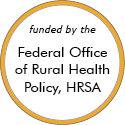Vermont Models and Innovations
These stories feature model programs and successful rural projects that can serve as a source of ideas. Some of the projects or programs may no longer be active. Read about the criteria and evidence-base for programs included.
Evidence-Based Examples
PROSPER Partnerships
Updated/reviewed June 2025
- Need: An approach to support sustained, quality delivery of evidence-based programs for youth and families in rural communities.
- Intervention: PROSPER, a program delivery system, guides communities in implementing evidence-based programs that build youth competencies, improve family functioning, and prevent risky behaviors, particularly substance use.
- Results: Youth in PROSPER communities reported delayed initiation of a variety of substances, lower levels of other behavioral problems, and improvements in family functioning and other life skills.
Project ENABLE (Educate, Nurture, Advise, Before Life Ends)
Updated/reviewed May 2025
- Need: To enhance palliative care access to rural patients with serious illness, such as advanced cancer, heart failure, and COPD, and their family caregivers.
- Intervention: Project ENABLE consists of: 1) an initial in-person palliative care consultation with a specialty-trained provider and 2) a semi-structured series of weekly, phone-delivered, nurse-led or palliative care coach/navigator sessions designed to help patients and their caregivers enhance their problem-solving, symptom management, and coping skills.
- Results: Patients and caregivers report higher quality of life and lower rates of depression and (caregiver) burden.
Effective Examples
Vermont Hub-and-Spoke Model of Care for Opioid Use Disorder
Updated/reviewed November 2025
- Need: In the early 2010s, needed increase access to medication treatment for opioid use disorder in rural Vermont.
- Intervention: 2012-2016 implementation of a statewide hub-and-spoke treatment access system.
- Results: The original system's increased treatment capacity and care coordination successes now are a permanent system of integrated care overseen by the Vermont state health department and Vermont Blueprint for Health.
University of Vermont Medical Center's Nursing Home Telepsychiatry Service
Updated/reviewed December 2023
- Need: To improve the health status and access for rural nursing home patients in need of mental health services.
- Intervention: The University of Vermont Medical Center provides telepsychiatry care and education to nursing homes in communities that face shortages of mental health professionals.
- Results: These telepsychiatry consultations have eased the burden on nursing home residents by saving travel time, distance, and money it takes to travel to the nearest tertiary facility.
Promising Examples
SASH® (Support and Services at Home)
Updated/reviewed April 2025
- Need: In Vermont, the growing population of older adults, coupled with a lack of a decentralized, home-based system of care management, poses significant challenges for those who want to remain living independently at home.
- Intervention: SASH® (Support and Services at Home), based in affordable housing and their surrounding communities throughout the state, works with community partners to help older adults and people with disabilities receive the care they need so they can continue living safely at home.
- Results: Compared to their non-SASH peers, SASH participants have been documented to have better health outcomes, including fewer falls, lower rates of hospitalizations, fewer emergency room visits, and lower Medicare and Medicaid expenditures.
Other Project Examples
CAPABLE (Community Aging in Place—Advancing Better Living for Elders)
Updated/reviewed July 2025
- Need: To help older adults age in place.
- Intervention: For four to five months, CAPABLE participants receive home visits from a registered nurse, occupational therapist, and home repair services.
- Results: There are currently 38 CAPABLE sites across the country, 19 of which are located in rural communities.
Vermont Food Access in Health Care (FAHC) Consortium

Updated/reviewed April 2025
- Need: To integrate healthcare with access to nutritious food in rural Vermont.
- Intervention: The Bi-State Primary Care Association and three FQHCs created food programs: Medically Tailored Meals, Produce Prescriptions, and Social Grocery Store.
- Results: These programs screen people for food insecurity, distribute food, offer health education sessions, and help people complete applications for other food programs.
Pathways Vermont Housing First Program
Updated/reviewed April 2021
- Need: Ending a local Vermont population's homelessness experience.
- Intervention: In 2010, Pathways Vermont implemented a first-of-its-kind, rural-focused Housing First program in order to provide housing and support services to those with mental health and substance use conditions experiencing homelessness.
- Results: Since its initial start-up, Pathways Vermont has assisted over 560 Vermonters — about 70% from rural areas — experiencing homelessness using the Housing First model. The organization has collaborated with the state mental health department, corrections department, local healthcare systems and providers, and other organizations to end homelessness. In addition, programmatic work has expanded to reach other local populations, including veterans and at-risk families.
Last Reviewed: 9/11/2025

